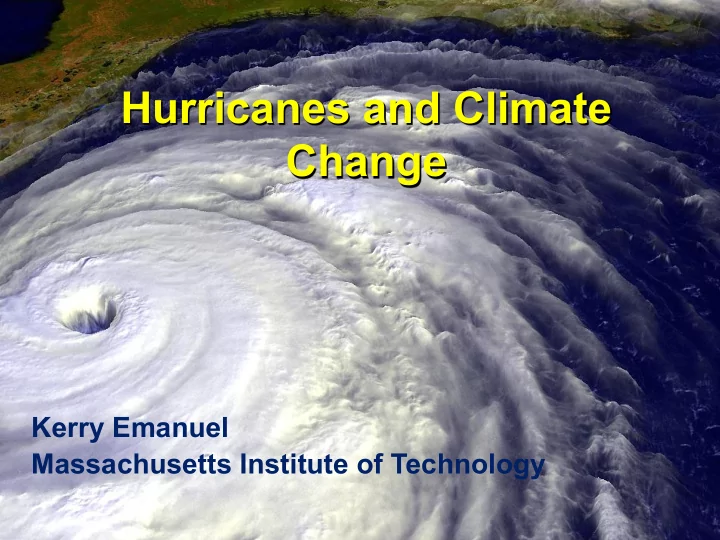

Hurricanes and Climate Change Kerry Emanuel Massachusetts Institute of Technology
Doubling ¡of ¡Atlan.c ¡PDI ¡for ¡~0.5 ¡C ¡increase ¡in ¡SST ¡
Global ¡mean ¡surface ¡temperature ¡ Tropical ¡Atlan3c ¡sea ¡surface ¡temperature ¡ Sulfate ¡aerosol ¡radia3ve ¡forcing ¡ Mann, ¡M. ¡E., ¡and ¡K. ¡A. ¡Emanuel, ¡2006. ¡Atlan3c ¡hurricane ¡trends ¡linked ¡to ¡climate ¡change. ¡EOS, ¡87, ¡233-‑244. ¡
Tropical ¡Atlan3c ¡Sea ¡Surface ¡Temperature ¡ Global ¡Surface ¡T ¡+ ¡Aerosol ¡Forcing ¡ Mann, ¡M. ¡E., ¡and ¡K. ¡A. ¡Emanuel, ¡2006. ¡Atlan3c ¡hurricane ¡trends ¡linked ¡to ¡climate ¡change. ¡EOS, ¡87, ¡233-‑244. ¡
Direct ¡(leN) ¡and ¡indirect ¡ (right) ¡aerosol ¡shortwave ¡ forcings ¡ Booth ¡et ¡al., ¡Nature, ¡ 2012 ¡ Detrended ¡3me ¡series ¡ of ¡ ¡aerosol ¡op3cal ¡ depth ¡and ¡effec3ve ¡ radius ¡
� Tropical cyclones account for the majority of insured losses worldwide � Atlantic hurricane power has more than doubled since the 1980s � Atlantic hurricane power tracks summer tropical Atlantic ocean temperature � Summer Atlantic ocean temperature seems to be controlled by radiative forcing, including greenhouse gases � Tropical cyclone activity in the western North Pacific region seems to be dominated by a natural climate oscillation there. ¡
Tropical ¡Cyclones ¡Tracks: ¡ ¡ What ¡will ¡happen ¡in ¡warming ¡world? ¡ Suzana ¡J. ¡Camargo ¡ Lamont-‑Doherty ¡Earth ¡Observatory ¡ Columbia ¡University ¡ Project ¡collaborators: ¡ ¡ Kerry ¡Emanuel ¡(MIT), ¡Adam ¡Sobel ¡(Columbia ¡ University), ¡Timothy ¡Hall ¡(NASA ¡GISS) ¡and ¡ ¡ James ¡Kossin ¡(NOAA) ¡
Ques.ons ¡being ¡inves.gated ¡ • Are ¡there ¡robust ¡and ¡significant ¡changes ¡in ¡ tropical ¡cyclone ¡tracks ¡(globally ¡and ¡regionally) ¡ in ¡a ¡warming ¡world? ¡ ¡ • If ¡there ¡are ¡significant ¡changes, ¡what ¡are ¡the ¡ causes ¡for ¡these ¡changes? ¡ ¡ • Is ¡there ¡predictability ¡for ¡track ¡changes? ¡
Methodology ¡to ¡inves.gate ¡track ¡ changes ¡ • Use ¡cluster ¡analysis ¡as ¡a ¡diagnos.c ¡for ¡track ¡ changes ¡under ¡a ¡warming ¡climate. ¡ • Tracks ¡from ¡dynamical ¡models ¡(CMIP5 ¡and ¡ other ¡model ¡simula.ons) ¡ • Tracks ¡from ¡sta.s.cal-‑dynamical ¡downscaling ¡ (Kerry ¡Emanuel ¡MIT) ¡ • Tracks ¡from ¡sta.s.cal ¡models ¡(Tim ¡Hall, ¡NASA ¡ GISS) ¡
Cluster ¡Analysis ¡of ¡North ¡Atlan.c ¡Tropical ¡ Cyclone ¡Tracks ¡ Kossin, ¡Camargo ¡and ¡Sitkowski, ¡2010 ¡
Preliminary ¡Results ¡from ¡a ¡few ¡CMIP5 ¡ models ¡in ¡the ¡North ¡Atlan.c ¡ • Models: ¡ – GFDL ¡ESM2M ¡ – HadGEM2 ¡ – MPI ¡ – MRI ¡CGCM3 ¡ • Scenarios: ¡ – Historical ¡ – RCP45 ¡and ¡RCP85 ¡
CMIP5 ¡models ¡– ¡Historical ¡runs ¡
MPI ¡– ¡Clusters ¡K4 ¡-‑ ¡Historical ¡tracks ¡
MPI ¡-‑ ¡Historical ¡& ¡RCP45 ¡
MPI ¡– ¡Historical ¡and ¡RCP85 ¡
Next ¡steps: ¡ • Apply ¡cluster ¡analysis ¡to ¡other ¡climate ¡models ¡in ¡ the ¡North ¡Atlan.c ¡ • Examine ¡the ¡op.mal ¡way ¡to ¡apply ¡cluster ¡analysis ¡ to ¡many ¡models ¡and ¡mul.ple ¡scenarios. ¡ • Determine ¡sta.s.cal ¡significance ¡of ¡track ¡changes ¡ • Apply ¡the ¡methodology ¡to ¡other ¡regions ¡(western ¡ North ¡Pacific, ¡southern ¡hemisphere, ¡etc) ¡ ¡ • Analysis ¡of ¡sta.s.cal-‑dynamical ¡and ¡sta.s.cal ¡ tracks ¡under ¡historical ¡and ¡warming ¡condi.ons ¡
Recommend
More recommend